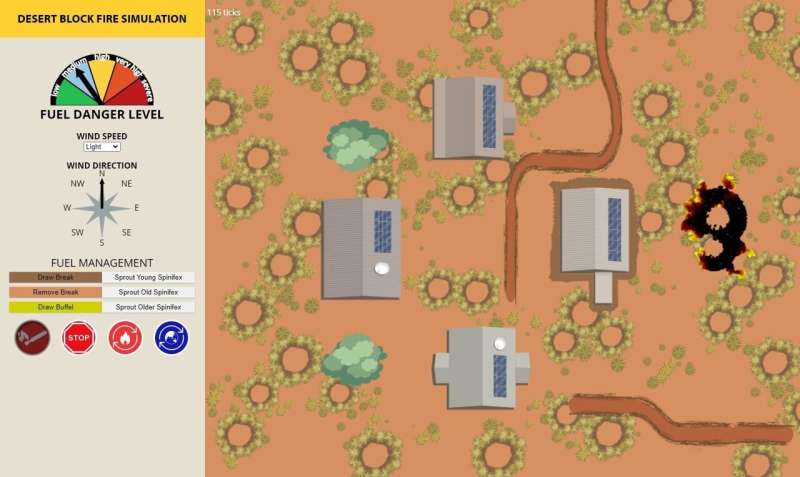This article has been reviewed according to Science X's editorial process and policies. Editors have highlighted the following attributes while ensuring the content's credibility:
fact-checked
trusted source
proofread
Desert fire simulation helps with education and engagement

A new simulation game is helping Indigenous rangers, landowners, children and more to learn about fire behavior and how they can mitigate the increasing threat of infernos.
The Desert Block Fire Simulation, developed by the Indigenous Desert Alliance and Charles Darwin University's (CDU) Northern Institute, contains three games in which users can learn about the challenges of fires in desert country.
The simulation shows how weather, wind and spinifex grass affect how fires behave, with users tasked to protect buildings, waterholes and the Tjakura burrows, home of the great desert skink. Users can sprout spinifex, add the invasive Buffel grass, set sparks and watch how the fire burns and travels.
CDU Northern Institute Researcher Dr. Rohan Fisher and his team has worked with the Indigenous Desert Alliance over the past year to develop the simulation.
"We learn by doing. Rather than telling people what do to, they are teaching themselves," Dr. Fisher said.
The game follows an earlier simulation created by Dr. Fisher and his team in 2018, working alongside Bushfires NT to develop the Darwin Rural Fire Simulation. Users must protect homes on rural blocks as the game simulates the behavior of bushfires fueled by gamba grass.
Since the simulation's release, it has become a crucial part of community engagement with Bushfires NT and incorporated into teaching at a local school in the Top End's Dundee region.
"Kids took these lessons to their parents, and it was a driver in efforts to control gamba grass in the Dundee region," Dr. Fisher said.
"It's amazing to go from a game to having significant impacts on the ground."
Dr. Fisher hopes the desert simulation will have the same success and is working with regions around Australia to develop similar applications in different settings.
"You can't use the simulation to predict fires, but you can use it for engagement and building resilience," Dr. Fisher said.
"There are applications of this work across a range of environments, and also for areas such as disaster risk mitigation and resourcing."
Provided by Charles Darwin University





















